MAZDA MODEL MX-5 MIATA RF 2020 Service Manual
Manufacturer: MAZDA, Model Year: 2020, Model line: MODEL MX-5 MIATA RF, Model: MAZDA MODEL MX-5 MIATA RF 2020Pages: 566, PDF Size: 62.47 MB
Page 41 of 566
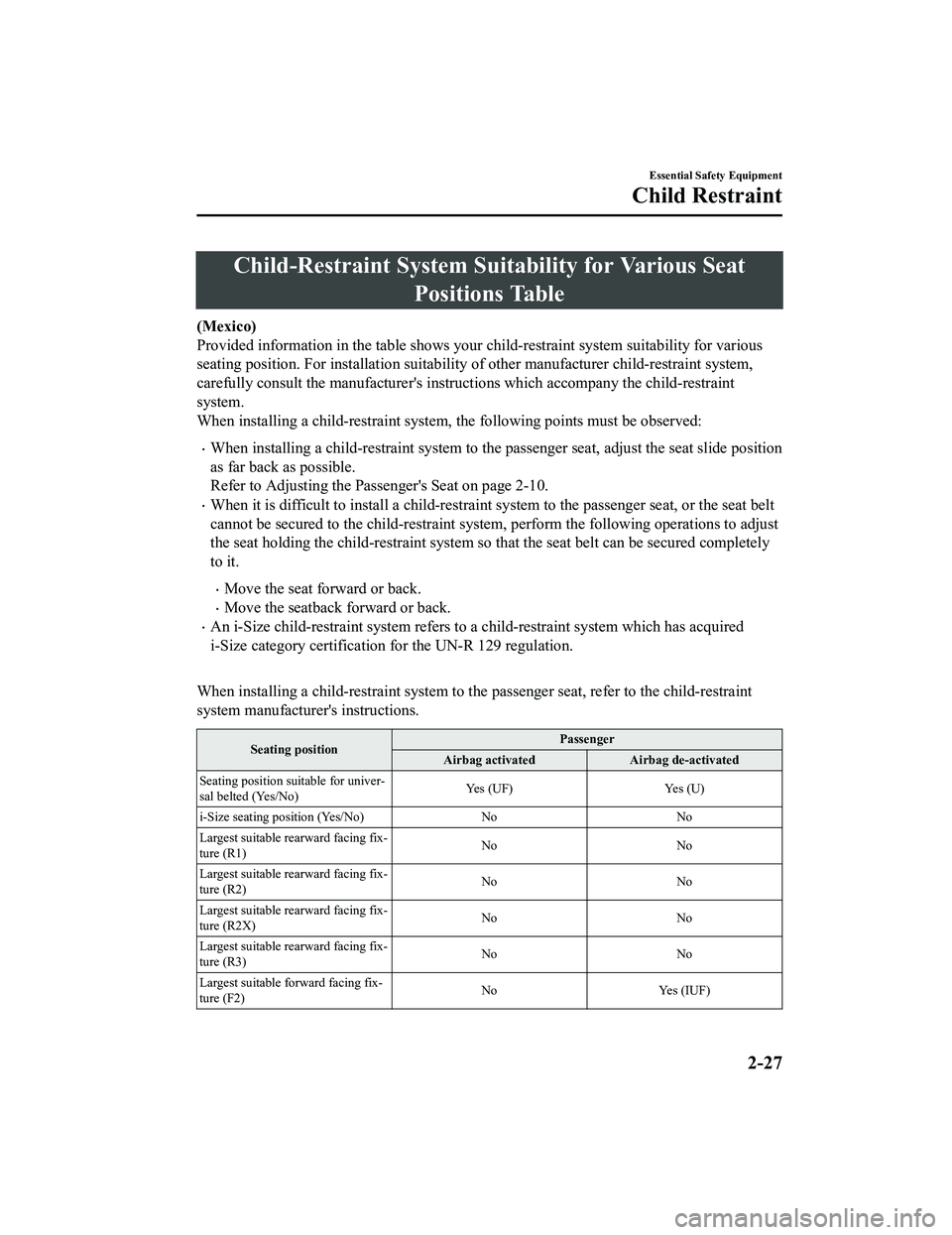
Child-Restraint System Suitability for Various Seat
Positions Table
(Mexico)
Provided information in the tabl e shows your child-restraint system suitability for various
seating position. For installation suitability of other manufac turer child-restraint system,
carefully consult the manufacture r's instructions which accompany the child-restraint
system.
When installing a child-restraint system, the following points must be observed:
When installing a child-restraint system to the passenger seat, adjust the seat slide position
as far back as possible.
Refer to Adjusting the Passenger's Seat on page 2-10.
When it is difficult to install a child-restraint system to the passenger seat, or the seat belt
cannot be secured to the child-restraint system, perform the fo llowing operations to adjust
the seat holding the child-restra int system so that the seat belt can be secured completely
to it.
Move the seat forward or back.
Move the seatback forward or back.
An i-Size child-restra int system refers to a child-restraint sy stem which has acquired
i-Size category certification fo r the UN-R 129 regulation.
When installing a child-restraint system to the passenger seat, refer to the child-restraint
system manufacturer's instructions.
Seating position Passenger
Airbag activated Airbag de-activated
Seating position suitable for univer‐
sal belted (Yes/No) Ye s ( U F )
Ye s ( U )
i-Size seating position (Yes/No) NoNo
Largest suitable rearward facing fix‐
ture (R1) No
No
Largest suitable rearward facing fix‐
ture (R2) No
No
Largest suitable rearward facing fix‐
ture (R2X) No
No
Largest suitable rearward facing fix‐
ture (R3) No
No
Largest suitable forward facing fix‐
ture (F2) No
Yes (IUF)
Essential Safety Equipment
Child Restraint
2-27
MX-5_8JA4-EA-19K_Edition1_old 2019-8-29 16:18:06
Page 42 of 566

Seating positionPassenger
Airbag activated Airbag de-activated
Largest suitable forward facing fix‐
ture (F2X) No
Yes (IUF)
Largest suitable forward facing fix‐
ture (F3) No
No
Largest suitable lateral facing fix‐
ture (L1) No
No
Largest suitable lateral facing fix‐
ture (L2) No
No
Largest suitable booster fixture (B2) NoNo
Largest suitable booster fixture (B3) NoNo
Non i-size compatible with a sup‐
port leg (Yes/No) No
Yes
Lower ISOFIX anchorages but
without Top Tether (Yes/No) No
No
U = Suitable for “universal” category restraints approved for u se in this mass group.
UF = Suitable for forward-facing “universal” category restraints approved for use in this mass group.
IUF = Suitable for ISOFIX forward child restraints systems of universal category approved for use in the mass
group.
L = Suitable for particular child restraints given on attached list. These restraints may be of the “specific vehicle”,
“restricted” or “semi- universal” categories.
IL = Suitable for particular ISO FIX child restraint systems (CR S) given in the attached list. These ISOFIX CRS are
those of the “specific vehicle”, “restricted” or “semi-universal” categories.
i-U = Suitable for i-Size “univers al” Child Restraint Systems forward and rearward facing.
i-UF = Suitable for forward-facing i-Size “universal” Child Res traint Systems only.
Yes = Child-restraint system can be secured on the seat.
No = Child-restraint system can not be secured on the seat, or there is no fixture.
X = Child-restraint system cannot be installed.
Regarding child-restraint systems which can be installed to your Mazda, consult an Authorized Mazda Dealer.
(Except Mexico)
Regarding child-restraint system s which can be installed to your Mazda, consult an
Authorized Mazda Dealer.
Please comply with the legal regulations concerning the use of child-restraint systems in
your country.
For the CRS which do not carry t he ISO/XX size class identification (A to G), for the
applicable mass group, the child seat manufacturer shall indicate the vehicle specific
LATCH child-restraint systems recommended for each position.
Essential Safety Equipment
Child Restraint
2-28
MX-5_8JA4-EA-19K_Edition1_old 2019-8-29 16:18:06
Page 43 of 566
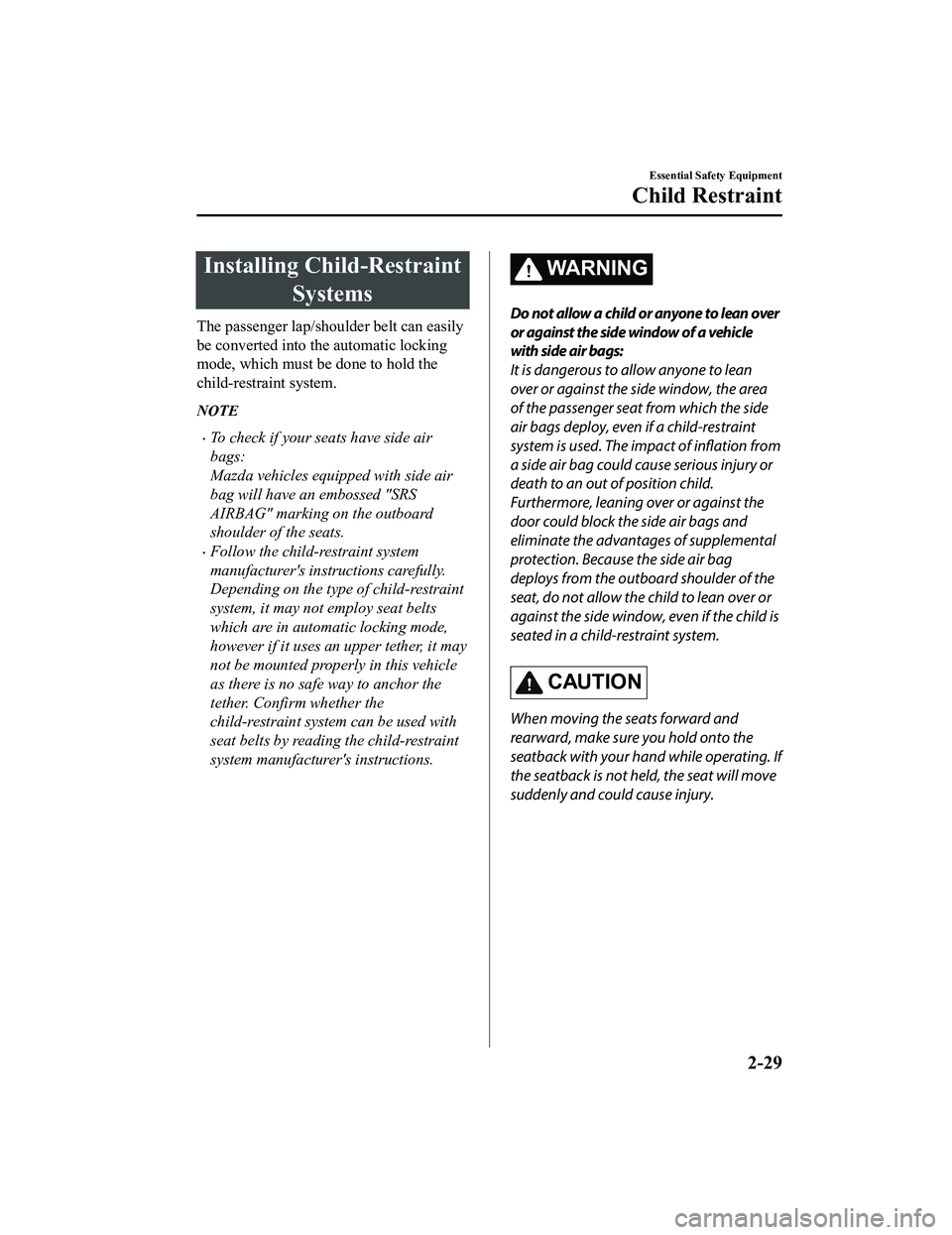
Installing Child-RestraintSystems
The passenger lap/shoulder belt can easily
be converted into the automatic locking
mode, which must be done to hold the
child-restraint system.
NOTE
To check if your seats have side air
bags:
Mazda vehicles equipped with side air
bag will have an embossed "SRS
AIRBAG" marking on the outboard
shoulder of the seats.
Follow the child-restraint system
manufacturer's instructions carefully.
Depending on the type of child-restraint
system, it may not employ seat belts
which are in automatic locking mode,
however if it uses an upper tether, it may
not be mounted properly in this vehicle
as there is no safe way to anchor the
tether. Confirm whether the
child-restraint system can be used with
seat belts by reading the child-restraint
system manufacturer's instructions.
WA R N I N G
Do not allow a child or anyone to lean over
or against the side window of a vehicle
with side air bags:
It is dangerous to allow anyone to lean
over or against the side window, the area
of the passenger seat from which the side
air bags deploy, even if a child-restraint
system is used. The impact of inflation from
a side air bag could cause serious injury or
death to an out of position child.
Furthermore, leaning over or against the
door could block the side air bags and
eliminate the advantages of supplemental
protection. Because the side air bag
deploys from the outboard shoulder of the
seat, do not allow the child to lean over or
against the side window, even if the child is
seated in a child-restraint system.
CAUTION
When moving the seats forward and
rearward, make sure you hold onto the
seatback with your hand while operating. If
the seatback is not he ld, the seat will move
suddenly and could cause injury.
Essential Safety Equipment
Child Restraint
2-29
MX-5_8JA4-EA-19K_Edition1_old 2019-8-29 16:18:06
Page 44 of 566
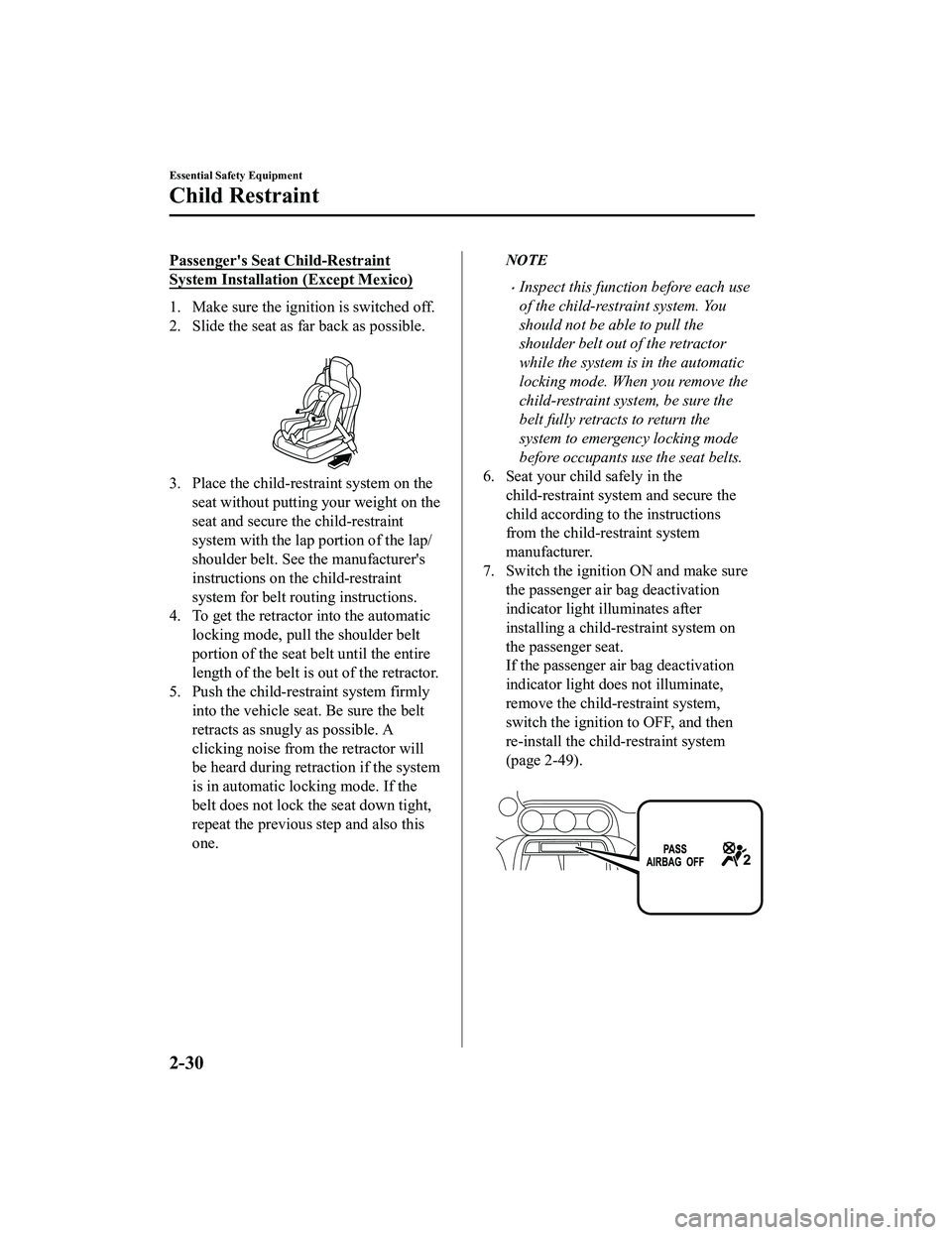
Passenger's Seat Child-Restraint
System Installation (Except Mexico)
1. Make sure the ignition is switched off.
2. Slide the seat as far back as possible.
3. Place the child-res traint system on the
seat without putting your weight on the
seat and secure the child-restraint
system with the lap portion of the lap/
shoulder belt. See the manufacturer's
instructions on the child-restraint
system for belt routing instructions.
4. To get the retractor into the automatic
locking mode, pull the shoulder belt
portion of the seat belt until the entire
length of the belt is out of the retractor.
5. Push the child-restraint system firmly into the vehicle sea t. Be sure the belt
retracts as snugly as possible. A
clicking noise from the retractor will
be heard during retraction if the system
is in automatic lo cking mode. If the
belt does not lock the seat down tight,
repeat the previous step and also this
one.
NOTE
Inspect this function before each use
of the child-restraint system. You
should not be able to pull the
shoulder belt out of the retractor
while the system is in the automatic
locking mode. When you remove the
child-restraint system, be sure the
belt fully retracts to return the
system to emergency locking mode
before occupants use the seat belts.
6. Seat your child safely in the child-restraint system and secure the
child according to the instructions
from the child-restraint system
manufacturer.
7. Switch the ignition ON and make sure the passenger air bag deactivation
indicator light illuminates after
installing a child-restraint system on
the passenger seat.
If the passenger a ir bag deactivation
indicator light does not illuminate,
remove the child-restraint system,
switch the ignition to OFF, and then
re-install the chil d-restraint system
(page 2-49).
Essential Safety Equipment
Child Restraint
2-30
MX-5_8JA4-EA-19K_Edition1_old 2019-8-29 16:18:06
Page 45 of 566
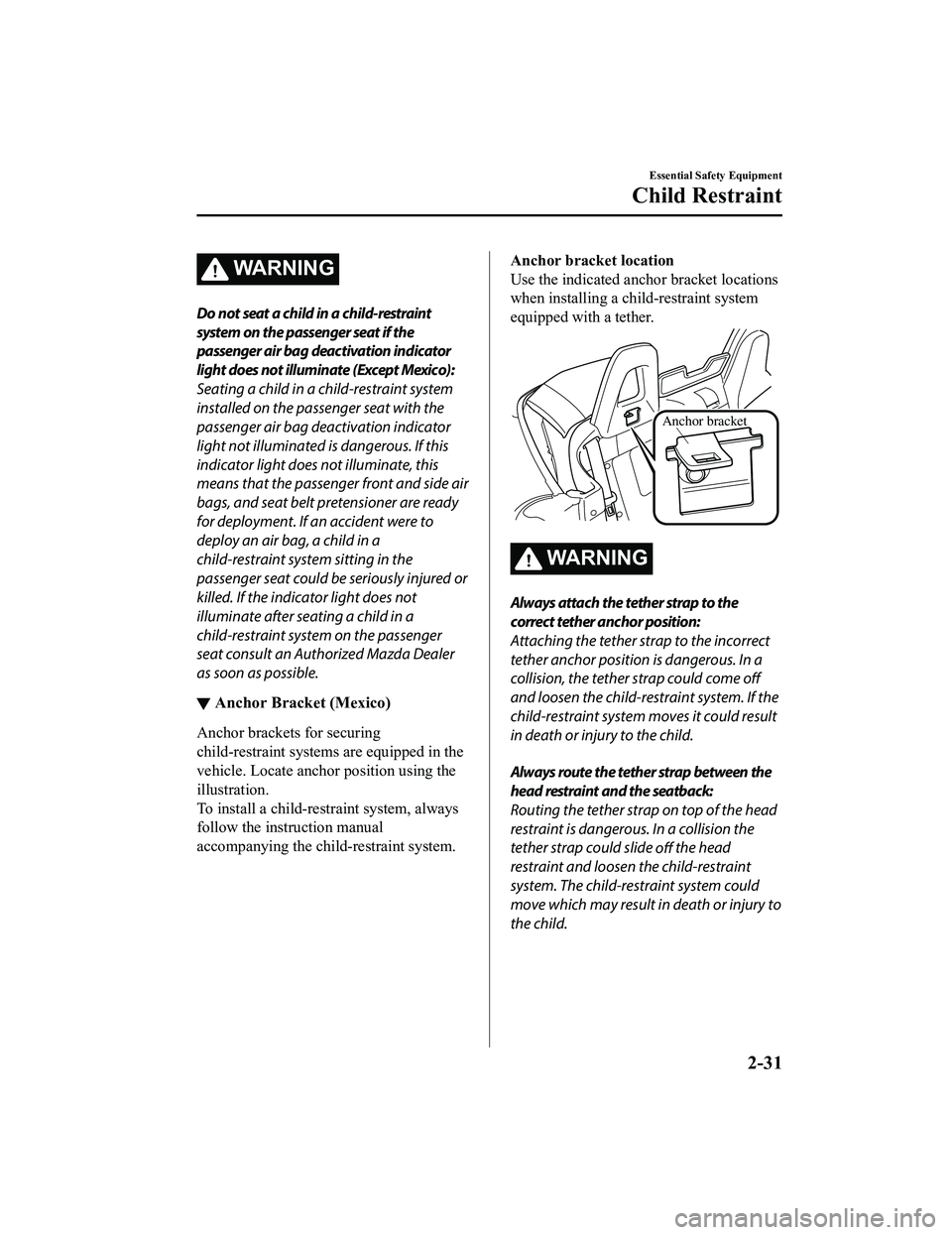
WA R N I N G
Do not seat a child in a child-restraint
system on the passenger seat if the
passenger air bag deactivation indicator
light does not illuminate (Except Mexico):
Seating a child in a child-restraint system
installed on the passenger seat with the
passenger air bag deactivation indicator
light not illuminated is dangerous. If this
indicator light does not illuminate, this
means that the passenger front and side air
bags, and seat belt pretensioner are ready
for deployment. If an accident were to
deploy an air bag, a child in a
child-restraint system sitting in the
passenger seat could be seriously injured or
killed. If the indicator light does not
illuminate after seating a child in a
child-restraint system on the passenger
seat consult an Authorized Mazda Dealer
as soon as possible.
▼Anchor Bracket (Mexico)
Anchor brackets for securing
child-restraint systems are equipped in the
vehicle. Locate anchor position using the
illustration.
To install a child-restraint system, always
follow the instruction manual
accompanying the child-restraint system.
Anchor bracket location
Use the indicated anchor bracket locations
when installing a child-restraint system
equipped with a tether.
Anchor bracket
WA R N I N G
Always attach the tether strap to the
correct tether anchor position:
Attaching the tether strap to the incorrect
tether anchor position is dangerous. In a
collision, the tether strap could come off
and loosen the child-restraint system. If the
child-restraint system moves it could result
in death or injury to the child.
Always route the tether strap between the
head restraint and the seatback:
Routing the tether strap on top of the head
restraint is dangerous. In a collision the
tether strap could slide
off the head
restraint and loosen the child-restraint
system. The child-restraint system could
move which may result in death or injury to
the child.
Essential Safety Equipment
Child Restraint
2-31
MX-5_8JA4-EA-19K_Edition1_old 2019-8-29 16:18:06
Page 46 of 566
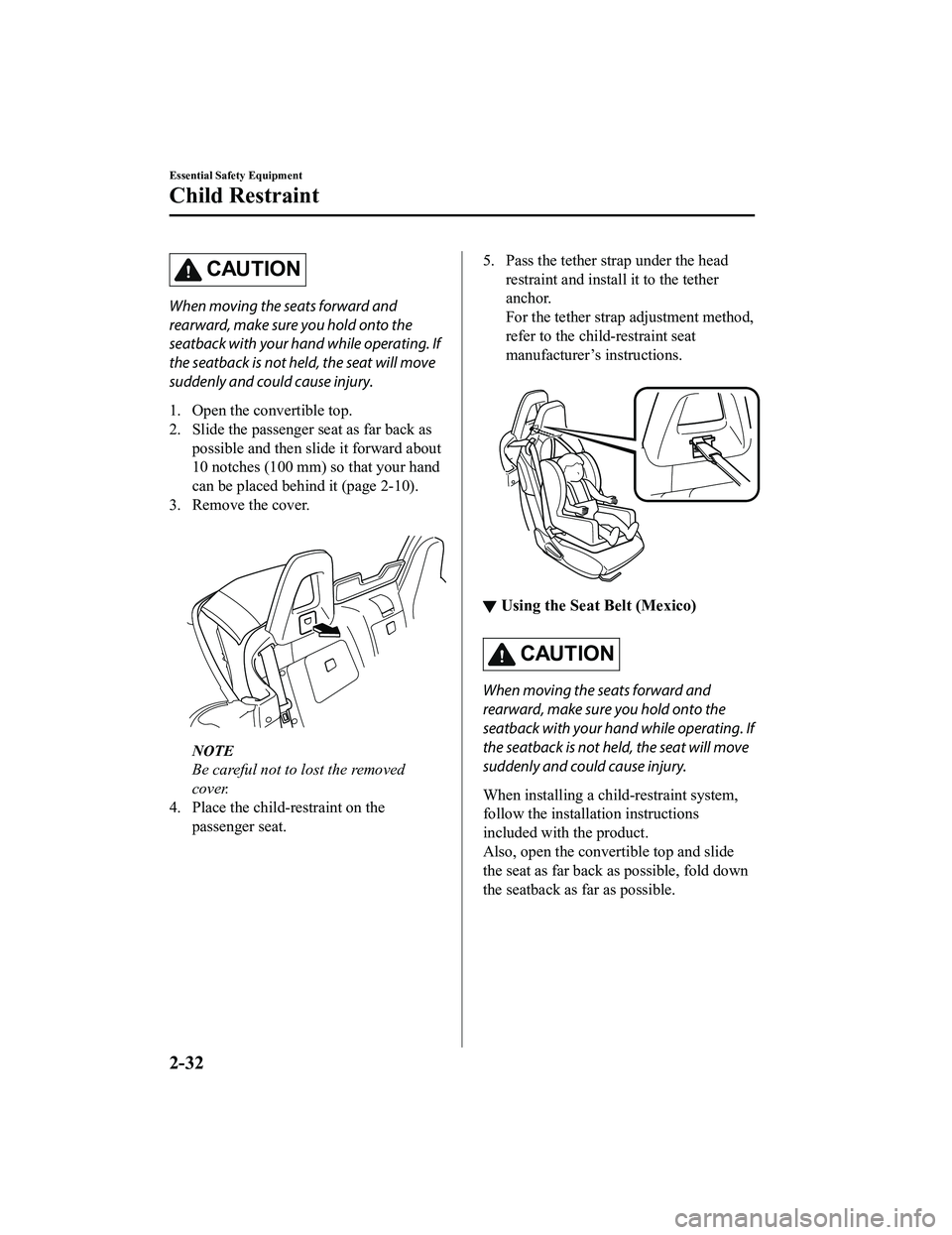
CAUTION
When moving the seats forward and
rearward, make sure you hold onto the
seatback with your hand while operating. If
the seatback is not held, the seat will move
suddenly and could cause injury.
1. Open the convertible top.
2. Slide the passenger seat as far back aspossible and then slide it forward about
10 notches (100 mm) so that your hand
can be placed behind it (page 2-10).
3. Remove the cover.
NOTE
Be careful not to lost the removed
cover.
4. Place the child- restraint on the
passenger seat.
5. Pass the tether strap under the head
restraint and install it to the tether
anchor.
For the tether strap adjustment method,
refer to the child-restraint seat
manufacturer’s instructions.
▼ Using the Seat Belt (Mexico)
CAUTION
When moving the seats forward and
rearward, make sure you hold onto the
seatback with your hand while operating. If
the seatback is not held, the seat will move
suddenly and could cause injury.
When installing a child-restraint system,
follow the installation instructions
included with the product.
Also, open the convertible top and slide
the seat as far back as possible, fold down
the seatback as far as possible.
Essential Safety Equipment
Child Restraint
2-32
MX-5_8JA4-EA-19K_Edition1_old
2019-8-29 16:18:06
Page 47 of 566

▼Using ISOFIX Anchor (Mexico)
WA R N I N G
Follow the manufacturer's instructions for
the use of the child-restraint system:
An unsecured child-restraint system is
dangerous. In a sudden stop or a collision it
could move causing serious injury or death
to the child or other occupants. Make sure
any child-restraint system is properly
secured in place according to the
manufacturer's instructions.
Make sure the child-restraint system is
properly secured:
A child-restraint system that is not secured
is dangerous. In a sudden stop or collision,
it can become a projectile and hit someone,
causing serious injury. When not in use,
remove it from the vehicle, put it in the
trunk or at least make sure it is securely
fastened to the ISOFIX anchors.
Make sure there are no seat belts or foreign
objects near or around the ISOFIX
anchor-secured child-restraint system:
Not following the child-restraint system
manufacturer's instructions when
installing the child-restraint system is
dangerous. If seat belts or a foreign object
prevent the child-restraint system from
being securely attached to the ISOFIX
anchors and the child-restraint system is
installed improperly, the child-restraint
system could move in a sudden stop or
collision causing serious injury or death to
the child or other occupants. When
installing the child-restraint system, make
sure there are no seat belts or foreign
objects near or around the ISOFIX anchors.
Always follow the child-restraint system
manufacturer's instructions.
CAUTION
When moving the seats forward and
rearward, make sure you hold onto the
seatback with your hand while operating. If
the seatback is not he
ld, the seat will move
suddenly and could cause injury.
1. Open the convertible top.
2. Make sure the ignition is switched off.
3. Slide the passenger seat as far back as
possible (page 2-10).
*1
*
1 You may need to move the seat forward slightly and recline the
back of the seat, in order to assist
in the fitment of some
child-restraint systems.
Essential Safety Equipment
Child Restraint
2-33
MX-5_8JA4-EA-19K_Edition1_old 2019-8-29 16:18:06
Page 48 of 566
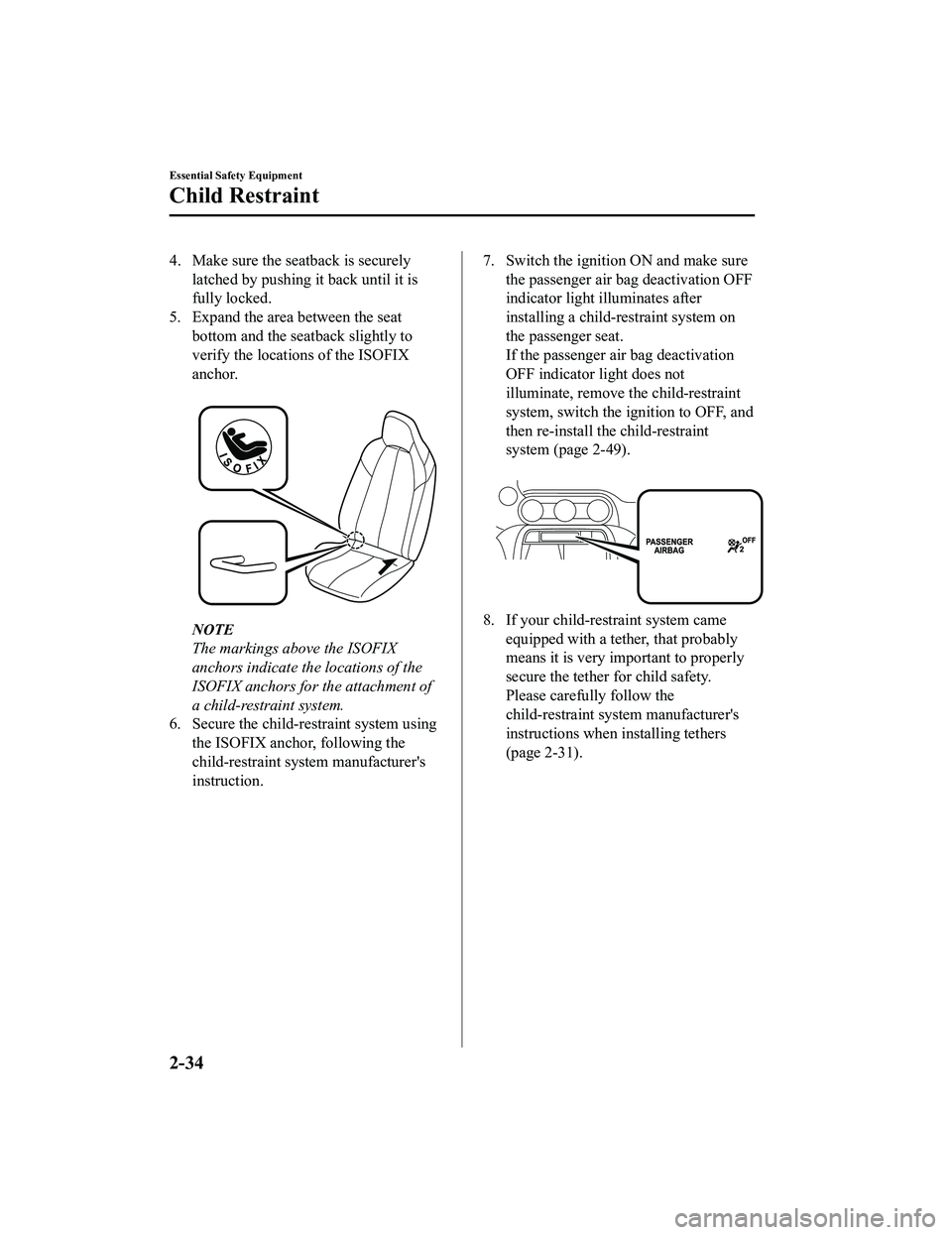
4. Make sure the seatback is securelylatched by pushing it back until it is
fully locked.
5. Expand the area between the seat bottom and the seatback slightly to
verify the locati ons of the ISOFIX
anchor.
NOTE
The markings above the ISOFIX
anchors indicate the locations of the
ISOFIX anchors for the attachment of
a child-restraint system.
6. Secure the child-restraint system using
the ISOFIX anchor, following the
child-restraint system manufacturer's
instruction.
7. Switch the ignition ON and make surethe passenger air bag deactivation OFF
indicator light illuminates after
installing a child-restraint system on
the passenger seat.
If the passenger a ir bag deactivation
OFF indicator light does not
illuminate, remove the child-restraint
system, switch the ignition to OFF, and
then re-install th e child-restraint
system (page 2-49).
8. If your child-restraint system came
equipped with a tether, that probably
means it is very important to properly
secure the tether for child safety.
Please carefully follow the
child-restraint system manufacturer's
instructions when installing tethers
(page 2-31).
Essential Safety Equipment
Child Restraint
2-34
MX-5_8JA4-EA-19K_Edition1_old 2019-8-29 16:18:06
Page 49 of 566
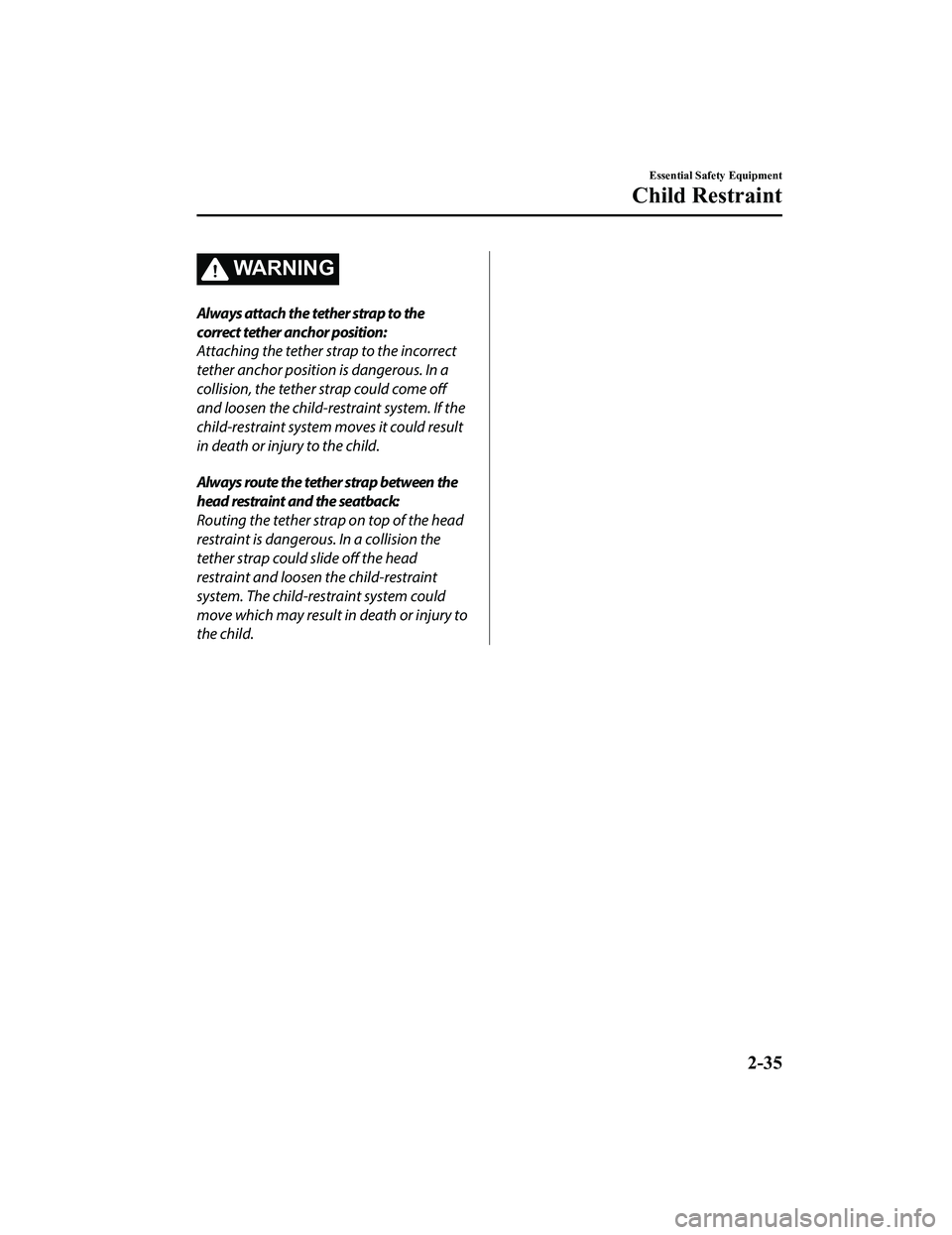
WA R N I N G
Always attach the tether strap to the
correct tether anchor position:
Attaching the tether strap to the incorrect
tether anchor position is dangerous. In a
collision, the tether strap could come off
and loosen the child-restraint system. If the
child-restraint system moves it could result
in death or injury to the child.
Always route the tether strap between the
head restraint and the seatback:
Routing the tether strap on top of the head
restraint is dangerous. In a collision the
tether strap could slide off the head
restraint and loosen the child-restraint
system. The child-restraint system could
move which may result in death or injury to
the child.
Essential Safety Equipment
Child Restraint
2-35
MX-5_8JA4-EA-19K_Edition1_old 2019-8-29 16:18:06
Page 50 of 566
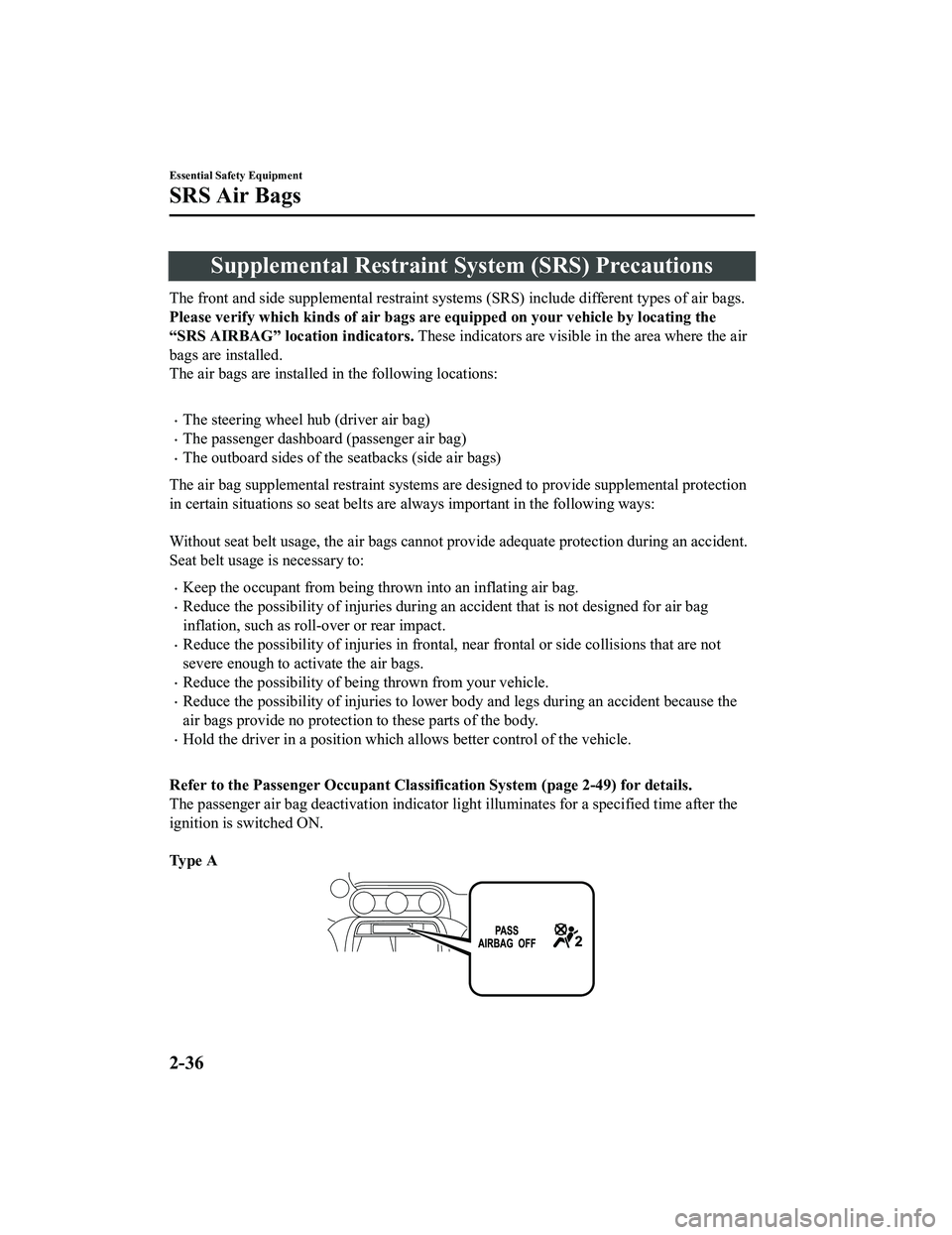
Supplemental Restraint System (SRS) Precautions
The front and side supplemental restraint systems (SRS) include different types of air bags.
Please verify which kinds of air bags are equipped on your vehi cle by locating the
“SRS AIRBAG” loca tion indicators. These indicators are visible in the area where the air
bags are installed.
The air bags are installed in the following locations:
The steering wheel h ub (driver air bag)
The passenger dashboard (passenger air bag)
The outboard sides of the seatbacks (side air bags)
The air bag supplemental restraint systems are designed to prov ide supplemental protection
in certain situations so seat bel ts are always important in the following ways:
Without seat belt usage, the air bags cannot provide adequate p rotection during an accident.
Seat belt usage is necessary to:
Keep the occupant from being thrown into an inflating air bag.
Reduce the possibility of injuries during an accident that is n ot designed for air bag
inflation, such as roll-over or rear impact.
Reduce the possibility of injuries in frontal, near frontal or side collisions that are not
severe enough to activate the air bags.
Reduce the possibility of being thrown from your vehicle.
Reduce the possibility of injurie s to lower body and legs during an accident because the
air bags provide no protection to these parts of the body.
Hold the driver in a position wh ich allows better control of the vehicle.
Refer to the Passenger Occupant Classification System (page 2-49) for details.
The passenger air bag deactivation indicator light illuminates for a specified time after the
ignition is switched ON.
Ty p e A
Essential Safety Equipment
SRS Air Bags
2-36
MX-5_8JA4-EA-19K_Edition1_old 2019-8-29 16:18:06